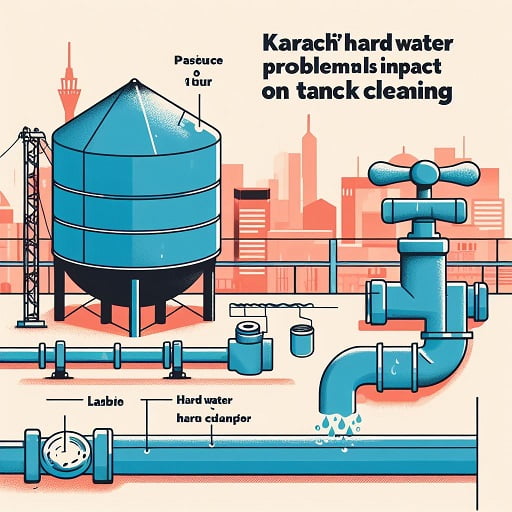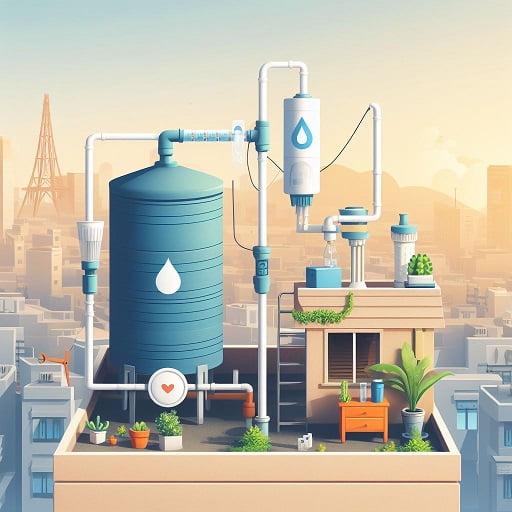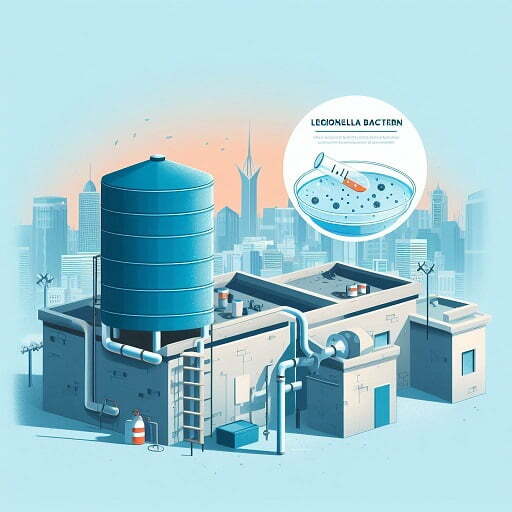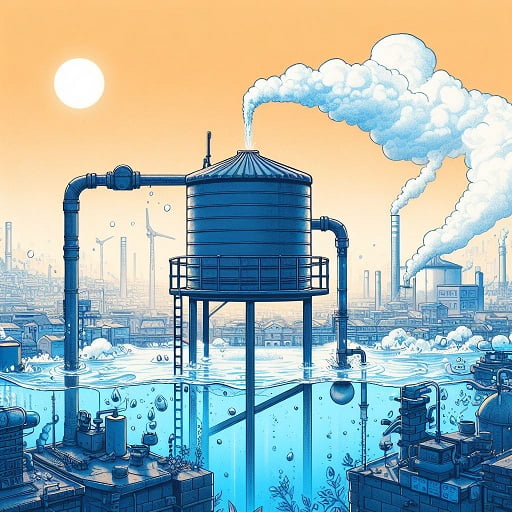Karachi is the largest and most populous city in Pakistan, with an estimated population of over 20 million people. It is also the economic, cultural, and political hub of the country, attracting millions of migrants, tourists, and businesses every year. However, Karachi also faces many challenges, such as poverty, crime, pollution, and water scarcity. One of the most pressing issues that affects the quality of life of Karachi’s residents is the hard water problem.
Hard water is water that contains high levels of dissolved minerals, such as calcium and magnesium. These minerals can cause various problems for household appliances, plumbing systems, and water tanks. Water tanks are essential for storing and supplying water in Karachi, especially during the dry season when the municipal water supply is often unreliable or insufficient. Therefore, it is important to understand the impact of hard water on tank cleaning and how to overcome this challenge.
The purpose of this article is to provide an overview of Karachi’s hard water problem and its impact on tank cleaning. It will also discuss the challenges in tank cleaning and the modern solutions that can help improve the water quality and safety in Karachi. Finally, it will present some case studies of successful tank cleaning in Karachi and the future outlook for addressing the hard water problem.
Understanding Hard Water
Hard water is defined as water that has a high concentration of dissolved minerals, such as calcium (Ca), magnesium (Mg), iron (Fe), and manganese (Mn). The hardness of water is measured in milligrams per liter (mg/L) or parts per million (ppm) of calcium carbonate (CaCO3). According to the World Health Organization (WHO), water hardness can be classified as follows:
- Soft: 0-60 mg/L
- Moderately hard: 61-120 mg/L
- Hard: 121-180 mg/L
- Very hard: >180 mg/L
Hard water can have various effects on household appliances, such as kettles, washing machines, dishwashers, showers, and faucets. Some of these effects are:
- Reduced efficiency and performance of appliances due to scale buildup and clogging
- Increased energy consumption and costs due to reduced heat transfer and increased resistance
- Reduced lifespan and durability of appliances due to corrosion and damage
- Reduced aesthetic appeal and quality of appliances due to staining and discoloration
The causes of hard water in Karachi are mainly geological and environmental. Karachi is located on the coast of the Arabian Sea, which has a high salinity level. The groundwater in Karachi is also influenced by the sea water intrusion, which increases the mineral content. Moreover, Karachi has a low rainfall rate and a high evaporation rate, which further concentrates the minerals in the water. Additionally, Karachi suffers from pollution and contamination from various sources, such as industrial waste, sewage, agricultural runoff, and solid waste. These contaminants can also contribute to the hardness of water by adding more minerals or chemicals.
Impact of Hard Water on Water Tanks
Water tanks are vital for storing and supplying water in Karachi. According to a survey conducted by the Pakistan Council of Research in Water Resources (PCRWR) in 2019, about 82% of households in Karachi use water tanks for domestic purposes. The average capacity of these tanks ranges from 500 to 2000 liters. The main sources of water for these tanks are municipal supply (46%), groundwater (34%), tanker supply (15%), and rainwater harvesting (5%).
However, water tanks are also susceptible to the effects of hard water. The most common problem is the accumulation of scale and mineral deposits on the inner walls and bottom of the tanks. Scale is a hard crusty layer that forms when calcium carbonate precipitates out of the water due to temperature changes or evaporation. Mineral deposits are solid particles that settle down at the bottom of the tanks due to gravity or filtration. These deposits can reduce the effective capacity and volume of the tanks, as well as interfere with the flow and pressure of the water.
Another problem is the reduced lifespan and durability of the tanks due to corrosion and damage. Corrosion is a chemical reaction that occurs when metal surfaces come into contact with oxygen or acidic substances in the water. Corrosion can cause holes, cracks, leaks, or rusting in the tanks, compromising their structural integrity and safety. Damage can also occur due to physical factors, such as temperature fluctuations, vibrations, or external impacts.
A third problem is the increased maintenance costs associated with hard water. Hard water can increase the frequency and complexity of tank cleaning operations, which require more time, labor, equipment, and chemicals. Hard water can also increase the need for repairs or replacements of damaged tanks or parts, which can be expensive and inconvenient.
Challenges in Tank Cleaning
Tank cleaning is an essential process for maintaining the quality and safety of water in Karachi. Tank cleaning involves removing any dirt, debris, scale, mineral deposits, algae, bacteria, or other contaminants from the tanks. Tank cleaning can also help prevent or reduce the problems caused by hard water, such as clogging, corrosion, or staining.
However, tank cleaning is not an easy task, especially in the context of hard water. There are several challenges that make tank cleaning difficult and ineffective. Some of these challenges are:
- Traditional tank cleaning methods: The most common methods of tank cleaning in Karachi are manual scrubbing, brushing, or scraping. These methods are labor-intensive, time-consuming, and inefficient. They also pose health and safety risks for the workers who have to enter the tanks and expose themselves to contaminated water or chemicals. Moreover, these methods are not able to remove all the scale and mineral deposits from the tanks, leaving behind some residues that can affect the water quality or cause re-deposition.
- Ineffectiveness of conventional cleaning approaches: Another challenge is the ineffectiveness of conventional cleaning approaches, such as using detergents, bleach, vinegar, or baking soda. These approaches are not able to dissolve or remove the hard water deposits from the tanks, as they are either too weak or too reactive. They can also damage the tanks or create harmful by-products that can contaminate the water or the environment.
- Health and environmental concerns: A third challenge is the health and environmental concerns associated with tank cleaning. Tank cleaning can generate a lot of wastewater that contains high levels of minerals, chemicals, or biological contaminants. This wastewater can pose a threat to the health of humans, animals, and plants if it is not properly disposed of or treated. It can also pollute the soil, groundwater, or surface water sources, affecting the ecosystem and biodiversity.
Modern Solutions for Tank Cleaning
In order to overcome the challenges of tank cleaning in hard water conditions, there is a need for modern solutions that can provide effective and efficient results. Some of these solutions are:
- Innovative tank cleaning techniques: One of the modern solutions for tank cleaning is to use innovative techniques that can remove the hard water deposits from the tanks without damaging them or creating waste. Some of these techniques are:
- High-pressure water jetting: This technique involves using a high-pressure pump to spray water at a speed of up to 3000 psi (pounds per square inch) on the tank surfaces. The water jet can dislodge and wash away any scale or mineral deposits from the tanks, leaving them clean and smooth.
- Chemical descaling: This technique involves using a specially formulated chemical solution to dissolve and remove the hard water deposits from the tanks. The chemical solution is circulated through the tanks using a pump and then drained out. The chemical solution is designed to be safe and biodegradable, minimizing any adverse effects on the tanks or the environment.
- Professional tank cleaning services: Another modern solution for tank cleaning is to hire professional tank cleaning services that can provide quality and reliable results. Professional tank cleaning services have the expertise, experience, equipment, and resources to perform tank cleaning operations in a safe and efficient manner. They can also offer customized solutions based on the type, size, condition, and location of the tanks. Some of the benefits of hiring professional tank cleaning services are:
- Reduced time and labor: Professional tank cleaning services can complete the tank cleaning operations in a shorter time and with less labor than traditional methods. They can also reduce the downtime and disruption of water supply during the cleaning process.
- Improved performance and durability: Professional tank cleaning services can improve the performance and durability of the tanks by removing all the scale and mineral deposits that can affect their function and structure. They can also prevent or reduce future buildup by applying protective coatings or treatments on the tanks.
- Enhanced quality and safety: Professional tank cleaning services can enhance the quality and safety of the water by eliminating any contaminants that can cause health problems or aesthetic issues. They can also ensure compliance with water safety standards and regulations by conducting tests and inspections on the tanks.
Maintenance Tips to Prevent Hard Water Buildup
In addition to using modern solutions for tank cleaning, it is also important to take some preventive measures to avoid or reduce hard water buildup in the tanks. Some of these measures are:
- Installing water softeners: Water softeners are devices that can reduce the hardness of water by removing or exchanging some of the minerals with sodium or potassium ions. Water softeners can be installed at the point of entry (where water enters the house) or at the point of use (where water is used for specific purposes). Water softeners can help prevent scale formation and improve the efficiency and lifespan of appliances.
- Using filters or purifiers: Filters or purifiers are devices that can remove impurities or contaminants from water by using physical, chemical, or biological processes. Filters or purifiers can be installed at various points in the water supply system, such as faucets, showers, or tanks. Filters or purifiers can help improve the taste, odor, color, and clarity of water.
- Flushing or draining regularly: Flushing or draining regularly: Flushing or draining is a simple and effective way to prevent hard water buildup in the tanks. Flushing or draining involves emptying the tanks completely and refilling them with fresh water. This can help remove any sediments or residues that may have accumulated at the bottom or the walls of the tanks. Flushing or draining should be done at least once a month or more frequently depending on the water quality and usage.
- Cleaning periodically: Cleaning periodically is another important measure to prevent hard water buildup in the tanks. Cleaning periodically involves performing a thorough and professional tank cleaning operation using modern techniques and services. Cleaning periodically can help remove any scale or mineral deposits that may have formed on the tank surfaces or pipes. Cleaning periodically should be done at least once a year or more often depending on the water hardness and condition of the tanks.
The Importance of Regular Tank Cleaning
Regular tank cleaning is not only a preventive measure, but also a necessity for ensuring the quality and safety of water in Karachi. Regular tank cleaning can have various benefits for the health, well-being, and comfort of Karachi’s residents. Some of these benefits are:
- Health risks associated with contaminated water: Contaminated water can cause various health problems, such as diarrhea, typhoid, cholera, hepatitis, dysentery, skin infections, and kidney stones. These diseases can affect the immune system, digestion, hydration, and nutrition of the people who consume or use the water. Regular tank cleaning can help prevent or reduce the occurrence of these diseases by removing any harmful bacteria, viruses, parasites, or chemicals from the water.
- Water quality and its impact on daily life: Water quality can also affect the daily life and activities of the people who use the water. Poor water quality can cause unpleasant taste, odor, color, or turbidity in the water. It can also damage or stain the clothes, dishes, utensils, or furniture that come into contact with the water. Moreover, poor water quality can affect the personal hygiene and appearance of the people who use the water for bathing, washing, or grooming. Regular tank cleaning can help improve the water quality and its impact on daily life by eliminating any impurities or residues that can cause these issues.
- Compliance with water safety standards: Water safety standards are guidelines or regulations that specify the acceptable levels of quality and purity of water for different purposes. Water safety standards are set by various authorities or organizations, such as the WHO, PCRWR, Sindh Environmental Protection Agency (SEPA), Karachi Water and Sewerage Board (KWSB), or Pakistan Standards and Quality Control Authority (PSQCA). Compliance with water safety standards is important for ensuring the health and welfare of the public and the environment. Regular tank cleaning can help ensure compliance with water safety standards by meeting or exceeding the criteria for physical, chemical, and biological parameters of water.
Case Studies
To illustrate the importance and effectiveness of regular tank cleaning in Karachi, here are some case studies of successful tank cleaning operations that have been conducted in different areas and sectors of the city.
- Example 1: Tank cleaning at a residential apartment complex in Gulshan-e-Iqbal
- Background: The apartment complex consists of 12 buildings with 240 flats and a total population of about 1200 people. The complex has a central water tank with a capacity of 100,000 liters that supplies water to all the flats. The tank was last cleaned 5 years ago and had accumulated a lot of scale and sediment over time.
- Problem: The residents of the complex complained about low water pressure, poor water quality, and frequent breakdowns of appliances. They also reported health issues such as skin rashes, hair loss, and stomach infections due to contaminated water.
- Solution: The management of the complex hired a professional tank cleaning service that used high-pressure water jetting and chemical descaling techniques to clean the tank. The service also applied a protective coating on the tank to prevent future scale formation. The service completed the tank cleaning operation in 2 hours and disposed of the wastewater in an environmentally friendly manner.
- Result: The residents of the complex noticed a significant improvement in the water pressure, quality, and safety after the tank cleaning operation. They also experienced less problems with their appliances and health. The management of the complex decided to schedule regular tank cleaning operations every year to maintain the optimal condition of the tank.
- Example 2: Tank cleaning at a hospital in Korangi
- Background: The hospital is a tertiary care facility that provides medical services to about 1000 patients per day. The hospital has a main water tank with a capacity of 500000 liters that supplies water to various departments and wards. The tank was last cleaned 3 years ago and had developed a lot of algae and biofilm over time.
- Problem: The hospital staff and patients complained about foul smell, discoloration, and turbidity in the water. They also reported cases of infections, allergies, and complications due to contaminated water.
- Solution: The hospital administration hired a professional tank cleaning service that used chemical descaling and disinfection techniques to clean the tank. The service also installed filters and purifiers on the tank outlets to ensure further purification of the water. The service completed the tank cleaning operation in 4 hours and followed all the safety protocols and standards.
- Result: The hospital staff and patients noticed a significant improvement in the smell, color, and clarity of the water after the tank cleaning operation. They also experienced less infections, allergies, and complications due to contaminated water. The hospital administration decided to schedule regular tank cleaning operations every 6 months to maintain.
Future Outlook
The hard water problem in Karachi is not a new or isolated issue, but a persistent and widespread one that affects millions of people and businesses in the city. However, there is also hope and potential for improvement and innovation in the field of water quality and tank cleaning. Some of the factors that can influence the future outlook of this issue are:
- Advances in water treatment technologies: Water treatment technologies are constantly evolving and improving to provide better and more efficient solutions for water quality and safety. Some of the emerging technologies that can help address the hard water problem in Karachi are:
- Reverse osmosis (RO): RO is a process that uses high pressure to force water through a semi-permeable membrane that filters out most of the dissolved minerals, salts, and contaminants. RO can produce soft and pure water that can be used for various purposes, such as drinking, cooking, or washing. RO systems can be installed at different scales, from household to industrial, depending on the water demand and availability.
- Nanofiltration (NF): NF is a process that uses low pressure to force water through a thin-film composite membrane that filters out most of the dissolved minerals, salts, and organic molecules. NF can produce soft and slightly acidic water that can be used for specific purposes, such as agriculture, food processing, or textile manufacturing. NF systems can be integrated with other treatment processes, such as RO or UV disinfection, to enhance water quality and safety.
- Ion exchange (IX): IX is a process that uses resin beads that are coated with sodium or potassium ions to exchange them with calcium or magnesium ions in the water. IX can produce soft and neutral water that can be used for general purposes, such as bathing, cleaning, or laundry. IX systems can be regenerated with salt solutions to restore their capacity and performance.
- Government initiatives to address water quality: Water quality is not only a technical or economic issue, but also a social and political one that requires the involvement and cooperation of various stakeholders, such as government agencies, private sector, civil society, and media. Some of the initiatives that can help address the water quality issue in Karachi are:
- Policy formulation and implementation: Policy formulation and implementation are essential for setting the goals, standards, and regulations for water quality and safety in Karachi. Policy formulation and implementation should be based on scientific evidence, public consultation, and stakeholder participation. Policy formulation and implementation should also be supported by adequate funding, monitoring, evaluation, and enforcement mechanisms.
- Infrastructure development and maintenance: Infrastructure development and maintenance are crucial for providing reliable and sufficient water supply and distribution systems in Karachi. Infrastructure development and maintenance should include upgrading or replacing the existing pipelines, pumps, valves, meters, reservoirs, or tanks that are old, damaged, or inadequate. Infrastructure development and maintenance should also include expanding or constructing new facilities or networks that can meet the growing or changing water demand and availability.
- Awareness raising and education: Awareness raising and education are important for increasing the knowledge, understanding, and appreciation of water quality and safety issues among the public and the media in Karachi. Awareness raising and education should include disseminating information, conducting campaigns, organizing events, or providing training on various aspects of water quality and safety, such as sources, standards, testing methods, treatment options, or tank cleaning practices. Awareness raising and education should also aim to change the attitudes, behaviors, and practices of the people towards water conservation, consumption, or management.
- Community participation and empowerment: Community participation and empowerment are essential for enhancing the ownership, responsibility, and accountability of the people for water quality and safety in Karachi. Community participation and empowerment should involve engaging and mobilizing the people to participate in decision making, planning, implementation, monitoring, or evaluation of water quality and safety initiatives or projects. Community participation and empowerment should also enable and support the people to access, demand, or advocate for their rights, needs, or interests related to water quality and safety.
Conclusion
Karachi’s hard water problem is a serious and complex issue that affects the quality of life of millions of people in the city. Hard water can cause various problems for household appliances, plumbing systems, and water tanks. Water tanks are vital for storing and supplying water in Karachi, but they are also susceptible to the effects of hard water. Hard water can reduce the capacity, performance, lifespan, and quality of the tanks. Therefore, it is important to understand the impact of hard water on tank cleaning and how to overcome this challenge.
Tank cleaning is an essential process for maintaining the quality and safety of water in Karachi. However, tank cleaning is not an easy task, especially in hard water conditions. There are several challenges that make tank cleaning difficult and ineffective. Therefore, there is a need for modern solutions that can provide effective and efficient results. Some of these solutions are innovative tank cleaning techniques that can remove the hard water deposits from the tanks without damaging them or creating waste. Another solution is professional tank cleaning services that can provide quality and reliable results.
In addition to using modern solutions for tank cleaning, it is also important to take some preventive measures to avoid or reduce hard water buildup in the tanks. Some of these measures are installing water softeners, using filters or purifiers, flushing or draining regularly, or cleaning periodically. These measures can help prevent scale formation, improve efficiency and durability of appliances, enhance quality and safety of water.
The hard water problem in Karachi is not a new or isolated issue, but a persistent and widespread one that affects millions of people and businesses in the city. However, there is also hope and potential for improvement and innovation in the field of water quality and tank cleaning. Some of the factors that can influence the future outlook of this issue are advances in water treatment technologies that can produce soft and pure water for various purposes; government initiatives to address water quality that can set goals, standards, and regulations for water quality and safety; awareness raising and education that can increase the knowledge, understanding, and appreciation of water quality and safety issues; and community participation and empowerment that can enhance the ownership, responsibility, and accountability of the people for water quality and safety.
In conclusion, Karachi’s hard water problem is a significant challenge that requires urgent attention and action from all stakeholders. By understanding the impact of hard water on tank cleaning and using modern solutions and preventive measures, we can improve the quality and safety of water in Karachi. By addressing the water quality issue, we can also improve the health, well-being, and comfort of Karachi’s residents.




